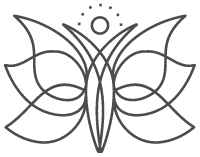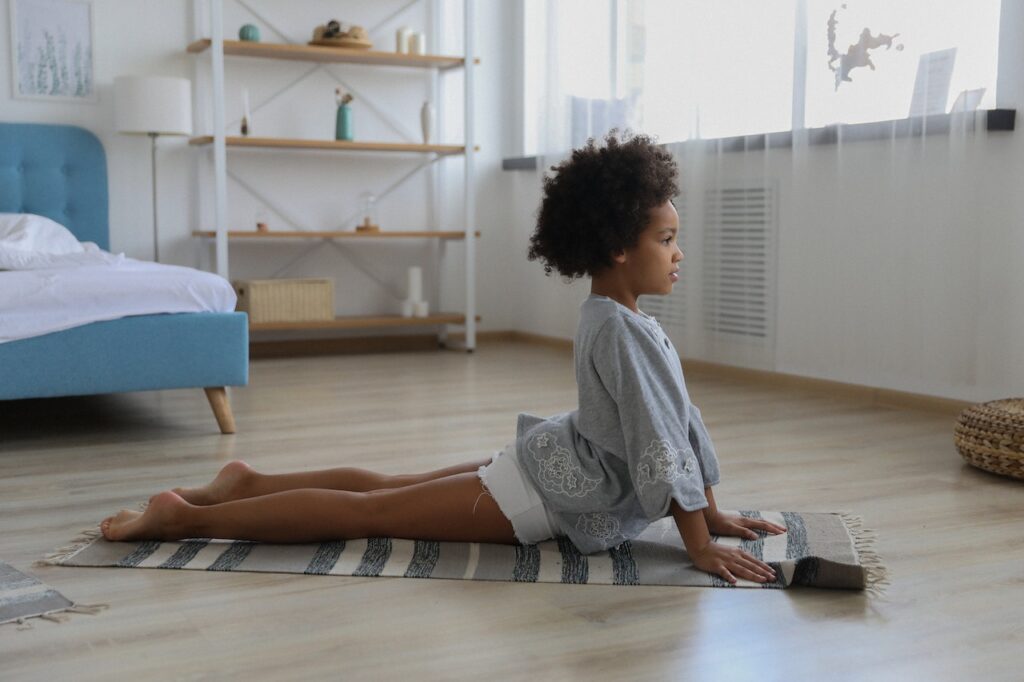Bhujangasana comes from the Sanskrit words “Bhujanga” (meaning “Cobra“) and “Asana” (meaning “Pose”).
Bhujangasana is a prone pose, which means that it requires you to lie down on your stomach. In this asana, you lie down on your stomach with your feet together and you use your palms to raise your upper body up from the floor. The final posture has your spine bent back and neck lifted upwards, resembling a cobra with raised hood.
Bhujangasana was first mentioned in Gheranda Samhita, one of the 3 classical texts of Hatha Yoga. The Gheranda Samhitha is a late 17th-century text on Hatha Yoga, composed of teachings passed on by sage Gheranda to his disciple Chanda Kapali. It describes 32 asanas, bhujangasana being one of them.
Although it has its origin in Hatha Yoga, Bhujangasana is widely practiced in most modern schools of yoga. A modified version in many modern schools of yoga such as Ashtanga Yoga is Urdhva Mukha Svanasana, where your knees and thighs are also raised from the ground in addition to your upper torso.
Bhujangasana is also the 7th step of traditional Surya Namaskar (Sun Salutation), a powerful sequence of 12 performed in dedication to the Sun God. The Ashtanga Surya Namaskar and it’s variations has Urdhva Mukha Svanasana, in place of bhujangasana.
This is a beginner-level back bending pose that helps us stretch our spine, strengthen our back muscles and tone our abdominal organs. It improves our breathing, relieves back pain and stiffness, and results in better posture.
How to do Bhujangasana
- Lie down on your stomach with your legs together and toes flat on the ground. Rest your forehead on the mat.
- Place your palms on the mat, next to your shoulders, with your fingers pointing forward.
- Keep your elbows close to your body parallel to each other
- Inhale and slowly lift your head, chest, and upper abdomen off the ground, while keeping your pelvis and lower abdomen on the mat.
- Your shoulders should be rolled back and down, away from your ears.
- Raise your head up and gaze up toward the sky.
- Take deep breaths while holding the pose. With each inhalation try to gently push your lower back down on the floor and raise your chest up toward the sky
- Hold the pose for a few breaths as long as you as comfortable
- Exhale and slowly lower your chest and head back to the mat.
Benefits of Bhujangasana
- Strengthens the back muscles, improving posture and reducing back pain and stiffness.
- Stretches the chest and shoulders, improving breathing and reducing tension in the upper body.
- Increases flexibility in the spine and back muscles.
- Boosts energy and circulation, by increasing blood flow to the spine and surrounding muscles
- Deep breathing can help to calm the mind and reduce stress and anxiety
- Can help reduce stress and anxiety by calming the mind and improving breathing.
- Relieves tension and pain in the back muscles
- Improves digestion by stimulating and massaging the digestive system
- Tones abdominal muscles
Therapeutic Benefits of Bhujangasana
Bhujangasana can be therapeutic for various diseases and conditions, particularly those related to the spine and respiratory system. Here are a few examples:
- Back pain: Bhujangasana can help to strengthen and stretch the muscles in your back, reducing pain and stiffness.
- Sciatica: The pose can help to stretch and release tension in the sciatic nerve, which can alleviate pain and discomfort associated with sciatica.
- Asthma: Bhujangasana can help to expand your chest and increase lung capacity, making it beneficial for those with asthma or other respiratory conditions.
- Digestive issues: The pose can help to stimulate the digestive system and improve circulation to the abdominal organs, aiding in digestion and elimination.
- Menstrual cramps: The pose can help to reduce menstrual cramps by stretching the abdominal muscles and increasing blood flow to the pelvic area.
Contraindications of Bhujangasana
- Back injury or pain: If you have back injury / severe back pain/back pain caused by underlying medical conditions, such as a herniated disc, spinal stenosis, or a muscle strain, it’s best to avoid Bhujangasana or any other backbend.
If you have with mild to moderate back pain / back pain due to a sedentary lifestyle, Bhujangasana can be beneficial for you when done properly and with proper modifications. You can try Sphinx Pose or Seal Pose, which is a gentle backbend that places less strain on your lower back.
- Pregnancy: If you are pregnant, it’s generally safe to practice Bhujangasana in the first trimester, but it’s best to avoid it in the second and third trimesters. During pregnancy, your abdominal muscles are stretched and weakened, and practicing backbends can put too much pressure on your lower back and abdomen. Instead, try Cat-Cow Pose, which is a gentle movement that helps stretch and strengthen your spine while also improving circulation and digestion.
- Carpal tunnel syndrome: If you have carpal tunnel syndrome, Bhujangasana can put pressure on your wrists and compress the carpal tunnel, aggravating the condition. It’s recommended to avoid the pose. You may practice modifications like Sphinx Pose or Seal Pose, which minimizes pressure on the wrists and hands. Other modifications that can be considered include reducing the amount of weight placed on your hands, such as by using props like blocks or a folded blanket to raise the height of your hands off the floor.
- Recent abdominal surgery / Hernia: If you have had abdominal surgery within the past six months or you are suffering from hernia, it’s best to avoid Bhujangasana and any other pose that puts pressure on your abdomen.
Modifications of Bhujangasana
- Baby Cobra Pose: Instead of lifting your chest off the ground, lift only your head and shoulders.If you can, lift your upper abdomen off the floor only as much as you are comfortable. You can keep your elbows bent to reduce the strain on your back.
- Salamba Bhujangasana (Sphinx Pose): Begin by lying on your stomach with your elbows directly beneath your shoulders and your forearms flat on the ground. As you inhale, press your forearms into the ground and lift your chest and head up, keeping your shoulders relaxed.
Variations of Bhujangasana
- Tiryaka Bhujangasana (Twisted Cobra Pose): After lifting your chest in Bhujangasana, exhale and twist your torso to the right side. Hold the pose for a few breaths. Exhale and come back to the center. Repeat on the other side. This additionally stretches the side muscles of your body.
- One-legged Cobra Pose: From Bhujangasana, lift one leg up off the ground while keeping your pelvis and shoulders level. Hold for a few breaths and then switch legs.
- Urdhva Mukha Svanasana (Upward-Facing Dog Pose) – From Bhujangasana, straighten your arms, lift your knees and hips off the ground, and push your chest forward to move into Upward-Facing Dog Pose.
Tips to Practice Bhujangasana
- Keep your shoulders relaxed, away from your ears and your elbows close to your sides to avoid straining your neck and shoulders.
- Breathe deeply and steadily throughout the pose.
- Engage your core muscles to protect your lower back.
- Try to be aware of the movement of your spine
Common Mistakes or Misalignments
- Hunching or lifting the shoulders too high causes tension in the neck and shoulders.
- Arching the lower back too much leads to lower back pain.
- Holding your breath or breathing shallowly.
Preparatory Poses
- Adho Mukha Svanasana (Downward-facing Dog Pose)
- Marjaryasana-Bitilasana (Cat-Cow Pose)
- Salamba Bhujangasana (Sphinx Pose)
Follow-Up Poses
- Niralamba bhujangasana
- Salabhasana
- Dhanurasana
- Ustrasana
- Purna Bhujangasana

